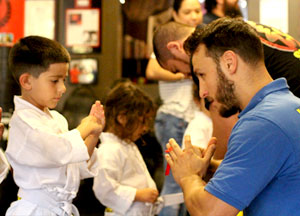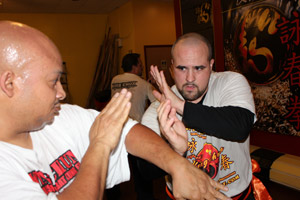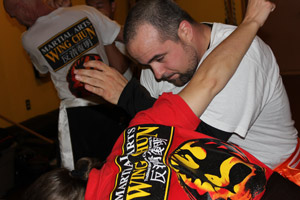Learning martial arts is much like a knife. You will take your training through stages before you can use it. The two main stages involved are crafting the knife and sharpening the knife. When to Learn Wooden Dummy & Chi Sau depends on your view point in regards to these stages. I will speak from the perspective that I was taught at Sifu Och Wing Chun. That doesn’t necessarily mean that it is the “correct” way, it is simply how we do it here.
Wooden Dummy and Chi Sau: Knowing When to Teach

Stage 1 – The view point that is at Sifu Och Wing Chun is one based in immediate application. When a student walks into our door we want to teach them street applicable techniques as soon as possible. We have had multiple students come into our studio living in dangerous situations. Our first advice is always to get away from the situation or people causing the problems. But when it comes to the techniques we can’t teach them Chi Sau or Wooden Dummy because at that moment it is not applicable.
They must be able to deal with dangerous situations and attacks immediately. We want to equip them with a basic defense against hooks, hard straight punches, take-downs, pushes, grabs etc. Once they have an established based we want to add onto their skill by adding combinations, transitions, and working against and with weapons. Finally, free sparring to train you on how to use and deal with other martial arts combat reactions.
The Need for Wooden Dummy and Chi Sau
Now, the argument might be made that without Chi Sau it will be difficult to enhance certain aspects of your reflexes. To this I agree to a point. In Chi Sau you deal with close quarter sensitivity reaction as well as redirection and close range trapping. So it is a vital aspect of training Wing Chun.

However, for the new student, Chi Sau may be difficult to use as a tool. You must train Chi Sau to learn structure before using it for reaction. Making sure that you have constant forward energy, balanced strength, and good relaxation can takes weeks to months of hard training.To fill in the gab between sparring and Chi Sau we use wrist against. This is essentially Chi Sau reaction hands without the rolling.
The same is essentially true with the wooden dummy. But instead of referring to reaction the wooden dummy would deal with structure and positioning refinement.
Stage 2

Stage 2 can be equated to the sharpening of the knife. You now have a good solid foundation in your techniques. You know how to apply them and it what situation they should be used. Now we must work to make them stronger, easier, more efficient. This is the perfect place for Chi Sau and Wooden Dummy. With the correct context in mind when applying the techniques, the refinement of them now has a purpose.
The Knife
Reverting back to the knife analogy. Imagine having a slab of metal and sharpening one side of it. Now, what do you have? A slab of metal with a sharp end. There is no way to use it as desired. Building the knife takes time. The handle, the guard if wanted, the length. You must make this part of the knife first before you can sharpen it. If you do not you are not only going to have a much hard time sharpening it but you will have an unusable knife.

Now, this goes without saying, all of the above depends on your goals. If you are seeking to learn Wing Chun to find balance in your life. Develop your mind and find new friends, then learning these aspects of Wing Chun sooner than later makes sense. However, if you are looking for the combat of Wing Chun then saving that for later is suggested for When to Learn Wooden Dummy & Chi Sau.
Why Choose Sifu Och Wing Chun?
Practicing provides numerous benefits, including:
- Physical Fitness: Enhance strength, flexibility, and endurance.
- Mental Clarity: Develop focus and discipline through structured training.
- Self-Defense Skills: Learn effective techniques for personal safety.
- Cultural Enrichment: Gain insight into a centuries-old tradition.

Want to Get Started?
Join Sifu Och Wing Chun today and embark on your journey through the world. Fill out our contact form to discover why we are your best choice for Wing Chun Kung Fu and martial arts training in Lakeland, Florida!
Related articles on the Sifu Och Wing Chun website:
Empower Yourself: Experience Personal Growth Through Chinese Martial Arts
https://sifuochwingchun.com/chinese-martial-arts-lakeland-florida-kung-fu/
Unlock Potential: The Incredible Strength of Wing Chun Martial Arts
https://sifuochwingchun.com/the-strength-of-my-wing-chun/


























 The Wing Chun wooden dummy is typically made of hard wood and has three protruding arms in different attack positions (jab, cross, gut shot) as well as a forward wooden or metal leg for kick applications. The Wing Chun Wooden Dummy form trains specific techniques that are performed simultaneously to increase and improve a practitioners self defense fighting application. Accuracy and proper technique are paramount to achieving the highest training potential the wooden dummy has to offer. Though many people and styles have bought and trained on the wooden dummy, not just any kind of martial art can get the maximum results the wooden dummy has to offer. The wooden dummy’s angles, structure, and posture were created for performing and training the aspects and angles of forward Wing Chun and Kung Fu fighting.
The Wing Chun wooden dummy is typically made of hard wood and has three protruding arms in different attack positions (jab, cross, gut shot) as well as a forward wooden or metal leg for kick applications. The Wing Chun Wooden Dummy form trains specific techniques that are performed simultaneously to increase and improve a practitioners self defense fighting application. Accuracy and proper technique are paramount to achieving the highest training potential the wooden dummy has to offer. Though many people and styles have bought and trained on the wooden dummy, not just any kind of martial art can get the maximum results the wooden dummy has to offer. The wooden dummy’s angles, structure, and posture were created for performing and training the aspects and angles of forward Wing Chun and Kung Fu fighting.
 Wing Chun wooden dummy training takes the development of timing, power, correct structure, coordination, mobility, footwork. If you want to increase your speed, structure, focus and mobility while harnessing your internal and external energy towards serious accomplishments, Wing Chun has all of the aspects to achieve it. The Wooden Dummy is just one of its tools to assist you in this path of great and serious accomplishment. The Wooden Dummy is static in it own nature but reactionary in both sound and movement against a mobile fighter allowing you to train on iron palm, iron arm, and combination fighting applications. ‘Wooden Dummy sparring’ or ‘Wooden Dummy fighting’ is a free form fighting method that amazing to watch and even more fun to practice when a pugilist full understands what they can do. A fighter (no matter what his/her background needs to acquire certain skills and abilities. Endurance to last the fight, speed, power and timing to deliver your blows without getting hit yourself and precision and accuracy while rooting and moving so you are not a static and immobile practitioner. A well rounded fighter has to know standup and ground defense, knife, gun and stick tactics as well as striking, kicking, throwing, chi na and countering. A well rounded fighter has to strengthen there arms, body, fists and legs to deliver powerful blows while being able to take blows and strikes if attacked or caught off guard.
Wing Chun wooden dummy training takes the development of timing, power, correct structure, coordination, mobility, footwork. If you want to increase your speed, structure, focus and mobility while harnessing your internal and external energy towards serious accomplishments, Wing Chun has all of the aspects to achieve it. The Wooden Dummy is just one of its tools to assist you in this path of great and serious accomplishment. The Wooden Dummy is static in it own nature but reactionary in both sound and movement against a mobile fighter allowing you to train on iron palm, iron arm, and combination fighting applications. ‘Wooden Dummy sparring’ or ‘Wooden Dummy fighting’ is a free form fighting method that amazing to watch and even more fun to practice when a pugilist full understands what they can do. A fighter (no matter what his/her background needs to acquire certain skills and abilities. Endurance to last the fight, speed, power and timing to deliver your blows without getting hit yourself and precision and accuracy while rooting and moving so you are not a static and immobile practitioner. A well rounded fighter has to know standup and ground defense, knife, gun and stick tactics as well as striking, kicking, throwing, chi na and countering. A well rounded fighter has to strengthen there arms, body, fists and legs to deliver powerful blows while being able to take blows and strikes if attacked or caught off guard.


